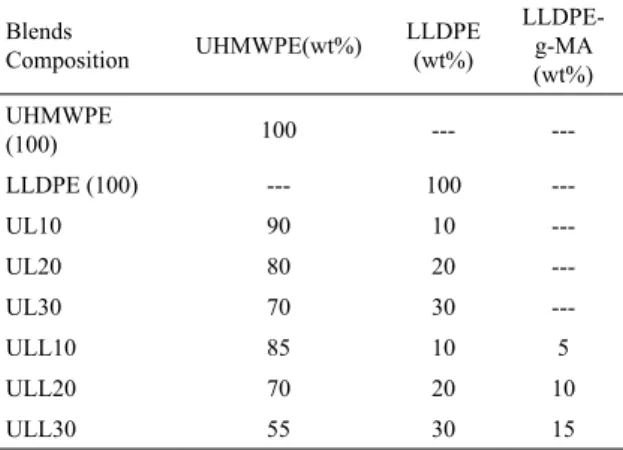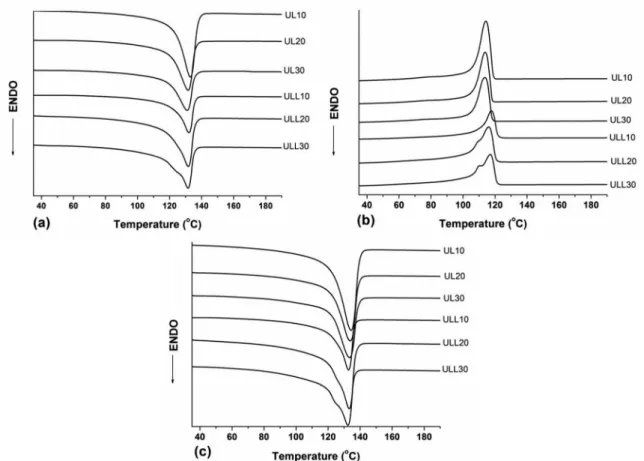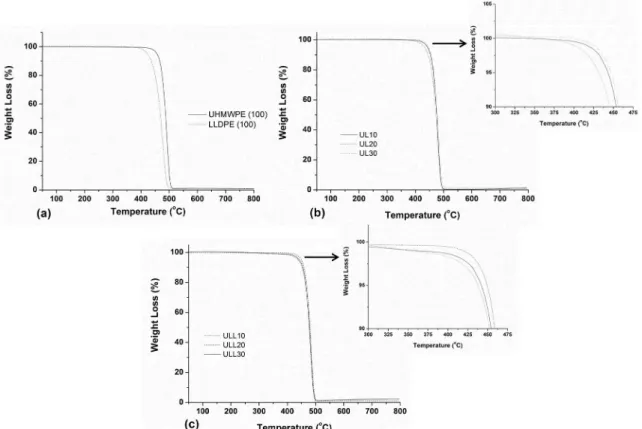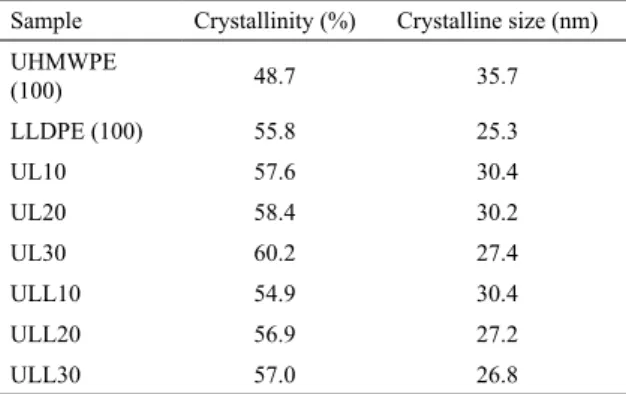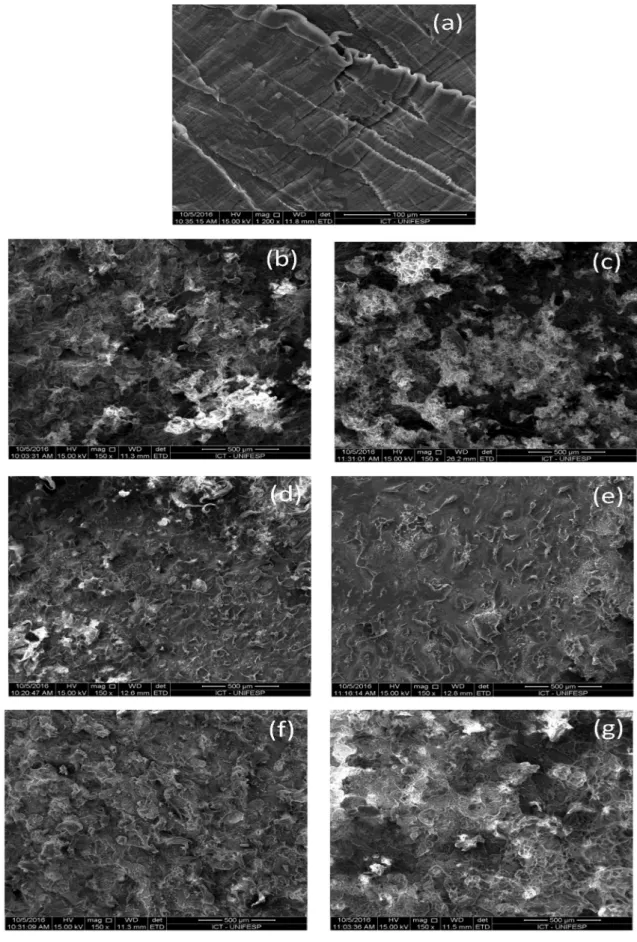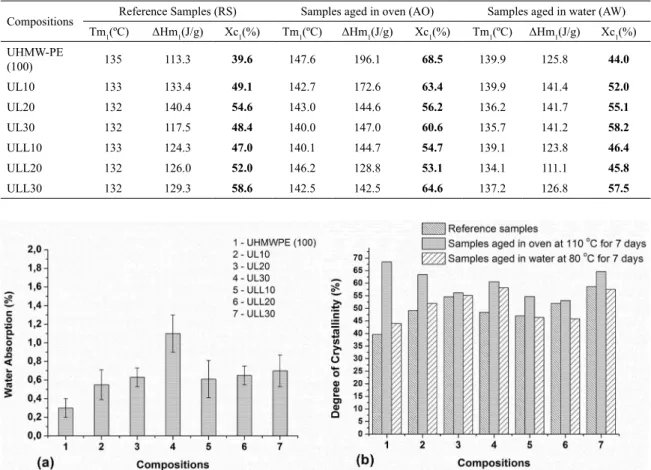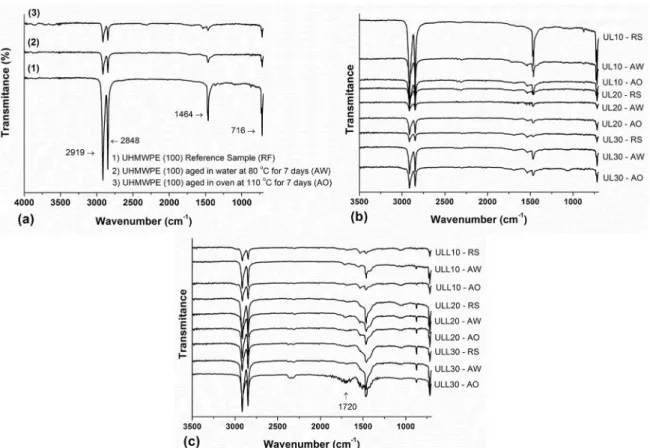Effect of LLDPE on Aging Resistance and Thermal, Mechanical, Morphological Properties
of UHMWPE/LLDPE Blends
Caroline Martins dos Santosa, Bruna Cristina da Silvaa, Eduardo Henrique Backesb,
Larissa Stieven Montagnaa, Luiz Antonio Pessanb, Fabio Roberto Passadora*
Received: May 02, 2018; Accepted: July 17, 2018
Blends of ultra-high molecular weight polyethylene (UHMWPE) and different contents (0, 10,
20 and 30 wt%) of linear low-density polyethylene (LLDPE) with and without maleic anhydride-grafted LLDPE (LLDPE-g-MA) were prepared by melt blending and aging resistance, thermal and mechanical properties were evaluated. The degree of crystallinity increases with the content of LLDPE
in the blends. On the other hand, the addition of compatibilizer agent modifies the crystallinity and
the crystallite size. Non-compatibilized blends have excellent impact resistance properties and the addition of LLDPE-g-MA aids processing but decrease the impact resistance of the blends. Thermal
and mechanical properties were greatly affected by thermal and water aging. The thermal aging leads
to an increase in the degree of crystallinity and consequent a decrease in impact resistance. Keywords: UHMWPE, LLDPE, polymer blends, aging resistance.
*e-mail: fabiopassador@gmail.com
1. Introduction
Ultra-high molecular weight polyethylene (UHMWPE) is a thermoplastic polymer that has extremely high molecular
weight and offers high impact resistance and toughness, elevated wear strength and fatigue resistance, low coefficient
of friction and high environmental stress cracking resistance1-4. Because of its mechanical properties, UHMWPE is widely used in automotive and aircraft ballistic protection, body
armor, fishing nets, hip/knee implants, and climbing rope5-8. Even above its melting temperature, UHMWPE still possesses a high melt viscosity, and cannot be processed through the mainstream thermoplastic processing techniques like extrusion and injection molding, the exception of compression molding and ram extrusion6 which largely restricts its efficiency of mass production. However, the processability of UHMWPE
can be improved by blending with conventional polyolefins4,6. The blending of such similar chemical nature of polyethylenes
may lead to a synergistic effect in terms of enhancement in
impact toughness and other mechanical properties9.
Due to the poor flow of UHMWPE, several techniques
are used to prepare UHMWPE blends, such as melt mixing, coarse powder blending followed by compression molding solvent blending and shear controlled orientation injection molding4,10-11. The incorporation of UHMWPE in other polyethylenes using the solvent blending technique provides good homogeneity, however, is not suitable for large-scale production, since it requires large quantities of solvent and the
protocols of mixing affect the final morphology of the blend.
On the other hand, UHMWPE/high-density polyethylene (HDPE) and UHMWPE/low-density polyethylene (LDPE)
blends can be prepared by melt mixing using conventional extruder but the incomplete melting of UHMWPE results
in a dispersion of particles which affect the properties of
the blends4,11.
Among the polyethylenes used to modify the UHMWPE,
HDPE has been used in many fields. UHMWPE can provide
many excellent properties on HDPE materials, such as outstanding mechanical properties, low friction, and low wear rate as well excellent fatigue resistance12. However, UHMWPE is still in a rubbery state even above its melting temperature and the UHMWPE particles will only suspend in the melted HDPE matrixes12. Instead, there is a distinct interface between HDPE matrix and dispersed UHMWPE particle, which may result in phase separation and poor performance of the blend13. Boscolleto et al.14 reported that
UHMWPE was only partially dissolved in HDPE/UHMWPE
blends during melt blending. In this case, the UHMWPE component cannot be well mixed with the HDPE matrixes. The major reason for that is low chain entanglements across the phase interfaces between HDPE and UHMWPE, which
are caused by extremely slow chain diffusion of UHMWPE.
Kyu and Vadhar15 have reported that cocrystallization takes
place in the blends of UHMWPE/HDPE blends. However, separate crystals are formed in UHMWPE/LDPE blends.
In this way, other processes have been studied. Chen et al.11 prepared HDPE/UHMWPE blends via solid-state shear milling and compared with the melt mixing blends and this process showed improvements in the strength and elongation
at break of HDPE/UHMWPE blends when compared to
aUniversidade Federal de São Paulo - UNIFESP, São José dos Campos, SP, Brasil
melt mixing blends. This same process was used for LDPE/
UHMWPE blends and the results were also very satisfactory4.
Thus, an effective way to prepare UHMWPE/polyethylene blends is the use of the intensive mixer/homogenizer, which
melts the polymer due to the high friction between the particles producing a homogeneous blend.
There are only a few reports regarding the preparation of
UHMDPE/linear low-density polyethylene (LLDPE) blends.
Chen et al.16 prepared LLDPE/UHMWPE blends with 10, 20, 30 and 40 wt% of UHMWPE by melt blending and reported inhomogeneity and phase separation in the system. The incorporation of a compatibilizer agent into the blend can promote interfacial adhesion and bonding of immiscible phases, through stabilization of phase morphology against
coalescence effects, which results in a reduction of dispersed
phase particle size. Several types of compatibilizer agents can be added to the polymer blend. The grafting of maleic
anhydride to the polyolefin backbone significantly increases
the polarity and, thus, can improve their surface hydrophilicity. The use of maleic anhydride (MA) as compatibilizer agent for polymer blends can promote a controlled morphology and enhanced mechanical properties17-18.
In this present study, UHMWPE/LLDPE blends with different contents of LLDPE were prepared by mechanical
melt mixing using maleic anhydride functionalized linear low-density polyethylene (LLDPE-g-MA) as compatibilizer agent and the structural, thermal and mechanical properties were correlated. The UHMWPE and LLDPE were chosen
because they have a similar chemical structure and different
melt index. The compatibilizer agent was chosen because it has the same melt index of the LLDPE and it is expected that the compatibilizer is miscible with the components of the polymer matrix. Moreover, this blend is of great importance for the production of individual protective equipment, such as protective helmets and ballistic shields, which are usually
mixed with polar fillers, so the study of the addition of the compatibilizer agent and the effect on the polymer blends may contribute to studies with polar fillers.
2. Experimental Procedure
2.1 Materials
The ultra-high molecular weight polyethylene, UHMWPE,
(UTEC 6540) with an intrinsic viscosity of 28 dL/g (ASTM
D 4020) and linear low-density polyethylene, LLDPE, (IC
32) with a melt index of 29 g/10 min (190°C/2.16 kg) were
supplied by Braskem, Brazil.
The maleic anhydride-grafted linear low-density polyethylene, LLDPE-g-MA, (Polybond® 3109) was purchased from Crompton Corporation. The LLDPE and LLDPE-g-MA were chosen because they have the same melt index (MI =
30 g/10 min (190°C/2.16 kg)).
2.2 Melt processing
UHMWPE was mixed together with LLDPE composition of 0, 10, 20 and 30 wt% respectively, using a high-speed mixer (Drais mixer produced by MH Equipamentos, Brazil, model MH50H) rotating at 3000 rpm and mixing chamber with a capacity of 70 g of material. The mixing, melting and homogenization of the blends occur due to the high friction generated between the rotor and the material. The mixing temperature was monitored using a thermocouple and reached 200ºC in 40 seconds mixing. After 1 min of mixing, the homogenized blends were collected and pressed into 3.2 mm thick plates in a hydropneumatic press (MH Equipamentos, Brazil, model PR8HP) at 200ºC with a pressure of 5 bar for 3 min. Standardized specimens for the impact test were prepared using a pneumatic hollow
die punch machine (CEAST/Instron). These UHMWPE/
LLDPE blends were denoted as UL.
UHMWPE/LLDPE blends with the addition of
LLDPE-g-MA were prepared using the same mixing methodology.
UHMWPE/LLDPE/LLDPE-g-MA blends with 10, 20 and 30 wt% of LLDPE and blending ratio of 2: 1
(LLDPE/LLDPE-g-MA) were prepared and denoted as ULL. The details of the investigated blends composition and their designation are presented in Table 1.
2.3 Characterization of the blends
The differential scanning calorimetry (DSC) analysis was
performed using TA Instruments QS100 equipment, under N2 atmosphere. The measurements of neat UHMWPE, neat
LLDPE, and UHMWPE/LLDPE blends were performed
according to the following procedures: samples were heated
to 200°C at 10°C.min-1 and kept at this temperature for 5 min
to erase any previous thermal history, then cooled to 40°C at 10°C.min-1 to determine the crystallization temperature (T
c). The melting point (Tm) was taken at the melting endothermic peak of the second heating cycle after erasing the thermal
Table 1. Composition and designation of UHMWPE/LLDPE and UHMWPE/LLDPE/LLDPE-g-MA blends. Blends Composition UHMWPE(wt%) LLDPE (wt%) LLDPE-g-MA (wt%) UHMWPE
(100) 100 ---
---LLDPE (100) --- 100
---UL10 90 10
---UL20 80 20
---UL30 70 30
---ULL10 85 10 5
ULL20 70 20 10
history. The degree of crystallinity (Xc) of the blends was determined from the Eq. 1.
(1)
where ΔHm is the enthalpy of fusion directly obtained by DSC, Hm
0
D , the enthalpy of fusion of 100% crystalline
polymer, was taken as 286.2 J/g for UHMW-PE and 140.6 J/g for LLDPE and φblend is the volume fraction of the
components in the blend.
The thermogravimetric analysis (TGA) of the compositions was performed using a Q50 TA Instruments equipment, from
room temperature to 800°C at a rate of 20 °C/min, under
N2 atmosphere.
The wide-angle X-ray diffraction (WAXD) was conducted
using a Rigaku Ultima IV (PANalytical, model X’pert Powder)
diffractometer, with Cu-Kα radiation (λ= 1.54056 Å), operating at 40 kV and 30 mA at a scan rate of 0.02º/s in a range of 2θ from 10 to 30º. The diffraction patterns data were used
to calculate the degrees of crystallinity and the crystallite sizes. Subsequently, through mathematical deconvolution
of the peaks in WAXD profiles, the overall crystallinity Xc
was calculated by Eq. 2 which correlates the sum of the area of all peaks associated with crystalline area divided by the sum of crystalline and amorphous peaks.
(2)
where Acryst and Aamorp are the fitted areas of crystalline
and amorphous peaks, respectively. The samples used were prepared by compression molding with the thickness of 3.2 mm. The apparent crystalline size was determined according to Scherrer’s equation (Eq. 3).
(3)
where β is the half-width of the diffraction peak in radians, K is equal to 0.9, θ is the Bragg angle and λ is the
wavelength of the X-rays. The values of D(hkl) for (110)
reflection were calculated.
The fracture surface morphology of the blends was analyzed by scanning electron microscopy (SEM). The samples were cryogenically fractured and covered with a thin layer of gold. The fracture surface was observed in a scanning electron microscope FEI Inspect S50, operating at 15 keV.
Impact tests were performed on a CEAST/Intron Charpy
impact testing machine (model 950). The test method adopted was carried out according to ASTM D256-78 method B. Five test specimens of each composition were notched using a
manual notched machine (CEAST/Instron). Impact loading
was done with a 5.5 J hammer.
2.4 Aging resistance
The regulatory standards of the Brazilian Army (NEB/T
E-316) and the National Institute of Justice (NIJ Standard 0101.04 - USA) for ballistic protection specify that for armor approval for personal use, samples must be aged in an air
circulation oven and in water at 70°C for 72 hours, seeking
to submit the material to the practical limits of application. However, this work intends to submit the samples under more severe conditions, in order to know the thermal resistance limit of the blends.
The aging resistance was analyzed by two methods: samples aged in water at 80ºC for 7 days (AW) and samples aged in
an oven at 110ºC for 7 days (AO). For the first method the
samples were placed in a distilled water circulation (Nova instruments), the water absorption (WA) of the samples was determined from the Eq. 4.
(4)
where mi is initial mass and mf is the mass after aging. In the second method, the samples were placed in an oven with
air circulation (Sterilifer, model SX CR/200). After aging the samples were characterized using differential scanning
calorimetry (DSC), Charpy impact tests and Fourier transform infrared spectroscopy (FTIR). For the DSC test, the samples
were heated to 200°C at 10°C.min-1 and only the first heating
was evaluated to verify the influence of aging on the degree of crystallinity. Impact tests were performed on a CEAST/
Intron Charpy impact testing machine (notched specimens and 5.5J hammer). FTIR was performed using a Shimadzu
spectrophotometer (model IR Affinity-1) the samples were mixed with potassium bromide (KBr) powder and pressed with 2 mm disk thickness. The measurement range was from 400 to 4000 cm-1.
3. Results and Discussion
Figures 1 and 2 show the DSC thermograms for neat
UHMWPE, neat LLDPE and the blends with different
contents of LLDPE. Table 2 summarizes the values of melting temperature (Tm1 and Tm2) obtained on the first and second heating scans and the values of crystallization temperature (Tc) obtained during the cooling scan and the
values of crystallinity degree for the first and second scan
(Xc1 and Xc2).
The neat LLDPE (Figure 1c) shows a bimodal and relatively broad peak due to its branching. The bimodal response is composed of a low temperature shoulder and a high temperature peak16. In Figure 1 b, UHMWPE exhibited higher crystallization peak (Tc) than LLDPE, but a lower crystallinity (Xc) (shown in Table 2). After the addition of LLDPE to the UHMWPE, there is a shift and change in melting point, which can be attributed to the van der Waals
%
.
,
X
cH
mH
m blend100
0
#
z
D
D
=
Q
V
R WX
A
A
A
c cryst amorp cryst=
+
/
/
/
cos
D
hklK
b
i
m
=
Q V
%
.
Figure 1. DSC thermograms of UHMWPE and LLDPE: (a) first heating, (b) cooling and (c) second heating.
Figure 2. DSC thermograms of UHMWPE/LLDPE blends and UHMWPE/LLDPE/LLDPE-g-MA blends: (a) first heating, (b) cooling
force between the two polymers21. For all blends prepared without addition of compatibilizer agent (UL) it was observed only a single crystallization temperature and a single melting temperature peaks (Figure 2 b) which becomes wider compared to those of the neat components indicating the existence of only one type of crystal species. These results may be an indicator of the miscibility of the system and that
co-crystallization took place in the UHMWPE/LLDPE blend.
Crystallization temperature (Tc) and melting temperature
(Tm) remained broadly unaffected (Table 2). It is noticed that
increasing the LLDPE content there is a slight increment in the degree of crystallinity of the blends, however, the degree of crystallinity is lower than LLDPE. This reduction may be attributed to the mobility restriction of LLDPE chains to
diffuse into UHMWPE high viscous matrix9.
On the other hand, the addition of compatibilizer agent in these systems (ULL) shows that increasing LLDPE content in the composition (ULL20 and ULL30) leads to a lower temperature shoulder peak and a higher temperature sharp peak in the crystallization curve (Figure 2 b), and they respectively correspond to the LLDPE component and
UHMWPE component. The difference between the behavior
of UHMWPE and LLDPE is a result of the branching since LLDPE has short chain branching while UHMWPE has an almost linear structure. According to Chen and co-workers16, the high temperature peak is attributed to the co-crystallization of linear fractions of LLDPE and UHMWPE, whereas, the broad shoulder at lower temperature represents melting of the lamellae formed by branched LLDPE chains. The appearance of two peaks could indicate a poor mixing or separate crystal formation. It is noteworthy that these compositions exhibit the large content of LLDPE since it was used the proportion of 2:1 (LLDPE: LLDPE-g-MA). Thus, the branching presents in the LLDPE-g-MA may also be contributing to the appearance of this shoulder which is
more evident/apparent for larger contents of LLDPE in the
blend. The degree of crystallinity of the ULL blends increased with the content of LLDPE and LLDPE-g-MA, indicating that the higher content of these components facilitates the
diffusion and enhance the mobility of the UHMWPE chains.
The higher content of LLDPE in the blends aids the processing
since LLDPE has high chain mobility, which allows greater mixing capacity and increases in the degree of crystallinity of the blends compared to neat UHMWPE.
Figure 3 shows the TGA curves of neat materials,
UHMWPE/LLDPE blends, and
UHMWPE/LLDPE/LLDPE-g-MA blends. The results are summarized in Table 2. The onset temperature (TO) of UHMWPE/LLDPE blends showed intermediate values between the individual polymers used. Increasing the content of LLDPE occurs a slight decrease in the values of onset temperature. This fact was already expected because the LLDPE has a lower onset temperature compared to UHMWPE. The addition of compatibilizer in the blends lead to a slight decrease in the onset temperature since the onset of decomposition of the maleic anhydride occurs at lower temperatures than for the polyethylene.
This fact can be confirmed by analyzing the results of the
compatibilized blends (ULL) with a high content of LLDPE. In all cases it was used a ratio 2:1 (LLDPE: LLDPE-g-MA), i.e., when increasing the LLDPE content in the blend we have double the content of compatibilizer agent and it results in a decrease of onset temperature. Similar results were obtained for polyethylenes blend-based organoclay nanocomposites compatibilized with LLDPE-g-MA19.
The X-ray scattering experiments were performed to obtain information about crystallinity and crystallite size of
the systems studied. The X-ray diffraction results are shown
in Figure 4. It can be seen that all samples have two
well-defined crystallographic plans, (1 1 0) and (2 0 0). There
are similar crystal structures for both neat UHMWPE and LLDPE, i.e. orthorhombic lattice, which is retained after the blending procedure20,21.
One simple approach to estimate the apparent degree of crystallinity from the WAXD experiment is to compute the integrated intensities of the pattern associated with the crystalline structures and the amorphous halo. Table 3 shows the values of crystalline parameters for UHMWPE,
LLDPE, and UHMWPE/LLDPE blends. As it is known that
the crystallinity is dependent on the molecular structure of the polymer chains. LLDPE has a higher content of short branched-chain segments compared to UHMWPE. However, the very high molecular weight of UHMWPE hinders Table 2. Values of Tm and Xc obtained during heating scans and Tc obtained during cooling scan, and values of onset temperature (TO)
obtained by TGA.
Tm1(ºC) Xc1(%) Tc (ºC) Tm2(ºC) Xc2(%) TO(ºC)
UHMWPE (100) 135 39.6 116 135 42.7 472.1
LLDPE (100) 125 60.9 109 124 61.2 448.0
UL10 133 49.1 114 134 52.1 464.1
UL20 132 54.6 114 134 56.7 462.0
UL30 132 48.4 113 136 59.5 461.5
ULL10 133 47.0 117 133 50.6 462.3
ULL20 132 52.0 116 133 56.1 460.5
crystallization. UHMWPE polymer chain may have size
30 times larger than the other polyolefin. Consequently,
the degree of crystallinity of UHMWPE is smaller than that of LLDPE. In addition, the crystallinity of the blend increases proportionally with the addition of LLDPE. The addition of compatibilizer agent decreased the crystallinity since it has lower crystallinity than LLDPE20. Similarly, increasing the content of LLDPE an increment in the degree of crystallinity was observed for these blends. Similar results on the decrease in crystallite size have already been reported
Figure 4. WAXD scans of (a) UHMWPE and LLDPE, and (b) compatibilized and uncompatibilized UHMWPE/LLDPE blends with differents contents of LLDPE.
Figure 3. TGA analysis (a) UHMWPE and LLDPE, (b) UHMWPE/LLDPE blends and (c) UHMWPE/LLDPE/LLDPE-g-MA blends.
for polyethylene based HDPE/UHMWPE blend system with
decrease UHMWPE content9. However, it can be observed a decrease in the crystallite size with the addition of LLDPE. The polyethylene presents orthorhombic crystalline and
the diffraction profiles are relative to the crystallographic
planes (110), (200) and (020). The apparent crystallite size was calculated using the plane (1 1 0) that correspond to the diagonal plane a-b. Concerning the intermolecular heterogeneity between UHMWPE and LLDPE (mainly
the rich domain of one kind of macromolecule, the regular arrangement of the chain segments of the other species might be excluded during crystallization and the crystal size becomes smaller21. The addition of compatibilizer agent also
influences the crystallite size. It is noted that increasing the
content of LLDPE (and consequently the content of LLDPE-g-MA) the size of the crystal decreases.
SEM micrographs of neat UHMWPE and the blends are presented in Figure 5. According to SEM images, the fractured surface of UHMWPE (Fig. 5a) presents uniform
morphology and a very flat surface, indicating a less ductile
behavior due to the high chain size and linear structure. The fractured surface of UL blends (Figures 5 b-d-f) present uniform morphology composed of millions of rod-like structure, and these tiny “rods” are connected with each other. The addition of LLDPE-g-MA modify the interior morphology of UHMWPE, and even voids can be observed (Figures 5 c-e-g). No evidence of a separate LLDPE phase was found; in view of a large number of images that were investigated, the absence of any visible separate LLDPE phase. A similar result was obtained by Jiang et al.22, that verified
the influence of maleic anhydride-grafted polyethylene in
blends of low-density polyethylene (LDPE) with polyamide-6
(PA6), i.e., the authors verified a good interfacial adhesion
between the phases.
The influence of aging on the thermal and mechanical
behavior of the blends is an important parameter to understand
the effect of weathering on the material. The studied samples were submitted to two different types of aging and correlated
with samples without aging (reference samples - referred to as RS). Table 4 shows the values of the Charpy impact strength of the notched samples. It was observed that the UHMWPE does not present total fracture for any type of aging. The reference samples of the blends without the addition of compatibilizer agent (UL) also did not present total fracture for the studied LLDPE contents. However, when submitted to both types of aging it presented total fracture.
On the other hand, the addition of LLDPE-g-MA affects
greatly the mechanical behavior once all the compatibilized samples presented total fracture.
Table 3. Values of crystalline parameters for UHMWPE, LLDPE, UL blends and ULL blends from X-ray data.
Sample Crystallinity (%) Crystalline size (nm)
UHMWPE
(100) 48.7 35.7
LLDPE (100) 55.8 25.3
UL10 57.6 30.4
UL20 58.4 30.2
UL30 60.2 27.4
ULL10 54.9 30.4
ULL20 56.9 27.2
ULL30 57.0 26.8
In order to understand the mechanical behavior of the samples, DSC analyzes were performed on all samples and the results are shown in Table 5. Figure 6a shows water absorption of samples aged in water at 80ºC for 7 days and Figure 6b presents the degree of crystallinity of all samples
studied. Only the first heating was evaluated to verify the influence of aging in the degree of crystallinity of the samples.
DSC analysis of the compositions showed that all samples aged in air circulation oven presented an increase in the degree of crystallinity due to the relief of the thermal stresses, resulting from the processing that allowed for the rearrangement of the molecules. The samples submitted to treatment in water also showed an increment in the crystallinity of neat UHMWPE and UL blends, but to a lesser extent, due to the water temperature, which was at 80ºC. No
plasticizing behavior was identified for the UL blends due
to the hydrophobic nature of the polymer material used. The
plasticizing effect decreases the degree of crystallinity since
it causes a reduction in the cohesive intermolecular forces along the polymer chains. Similar results on the increase in
crystallinity have already been reported for HDPE/LLDPE
blend when subjected to these aging23.
All samples aged in water showed low water absorption (Figure 6a). Increasing the content of LLDPE in the composition there is a slight increment in the water absorption, however,
as the polyolefins are hydrophobic these values did not alter
the structure of the polymer blends.
On the other hand, the addition of LLDPE-g-MA alters the degree of crystallinity of the blends when aged in water. The carbonyl groups are able to interact to a greater extent with the absorbed water molecules24. Hydrogen bonding between
water and the polar polymer has been confirmed by a shift
in the carbonyl peaks toward lower wavenumbers in FTIR spectrum, 1720 cm-1 (Figure 7c). One hypothesis is that a semicrystalline polymer with a lower degree of crystallinity, has a higher amount of amorphous phase and the amorphous
phase contains a finite amount of hydrophilic sites that
become saturated at some critical moisture content. Above this moisture content value, absorbed water molecules have a greater molecular mobility24-25. Then, the hydrogen bond interactions between the carbonyl group and water molecules decrease25, the polymer becomes plasticized and undergoes
structural changes which may then affect the mobility and
the degree of crystallinity of the blend.
Figure 5. SEM micrographs: (a) UHMWPE (100), (b) UL10, (c) ULL10, (d) UL20, (e) ULL20, (f) UL30 and (g) ULL30. Micrographs
Table 5. Melting temperature (Tm) and degree of crystallinity (Xc) of the samples aged in oven at 110ºC for 7 days (AO), samples aged in water at 80ºC for 7 days (AW) and reference samples (RF).
Compositions Reference Samples (RS) Samples aged in oven (AO) Samples aged in water (AW)
Tm1(ºC) ΔHm1(J/g) Xc1(%) Tm1(ºC) ΔHm1(J/g) Xc1(%) Tm1(ºC) ΔHm1(J/g) Xc1(%)
UHMW-PE
(100) 135 113.3 39.6 147.6 196.1 68.5 139.9 125.8 44.0
UL10 133 133.4 49.1 142.7 172.6 63.4 139.9 141.4 52.0
UL20 132 140.4 54.6 143.0 144.6 56.2 136.2 141.7 55.1
UL30 132 117.5 48.4 140.0 147.0 60.6 135.7 141.2 58.2
ULL10 133 124.3 47.0 140.1 144.7 54.7 139.1 123.8 46.4
ULL20 132 126.0 52.0 146.2 128.8 53.1 134.1 111.1 45.8
ULL30 132 129.3 58.6 142.5 142.5 64.6 137.2 126.8 57.5
Figure 6. (a) Water absorption of samples aged in water at 80ºC for 7 days and (b) Degree of crystallinity of reference samples, samples aged in oven at 100ºC for 7 days and samples aged in water at 80ºC for 7 days.
Table 4. Charpy impact strength of the notched reference samples (RS), samples aged in oven at 110 oC for 7 days (AO) and samples aged in water at 80 oC for 7 days (AW).
Samples Charpy Impact Resistance (J/m)
RS AO AW
UHMW-PE (100) NB* NB NB
UL10 NB 9.0 ± 0.8 11.5 ± 0.4
UL20 NB 2.9 ± 0.1 4.7 ± 0,1
UL30 NB 2.5 ± 0.1 3.1 ± 0.1
ULL10 11.4 ± 0.2 6.8 ± 0.1 9.2 ± 0.1
ULL20 6.7 ± 0.1 1.9 ± 0.1 6.2 ± 0.1
ULL30 5.5 ± 0.1 1.4 ± 0.1 4.9 ± 0.1
*NB - Not break
compatibilizer agent26-27. The presence of branching and
tertiary carbons in polyolefin chains makes them susceptible
to attack by free radicals and oxygen and, therefore, to degradation26. Thermo-oxidation of UHMWPE and LLDPE
can significantly affect the physicochemical properties of
polymers, such as increased crystalline fraction, elastic modulus, and impact properties27. It is observed that no thermo-oxidative processes occurred since the exposure time was reduced, so the decrease of the impact resistance
to samples aged in the oven is due to the increase in the degree of crystallinity.
For samples aged in the oven for 7 days, identified as
AO, a decrease in impact strength is observed. The increase
in the degree of crystallinity increases the stiffness of the
material and consequently reduces the impact resistance. By increasing the content of LLDPE in the compositions, lower values of impact resistance are observed.
4. Conclusions
UHMWPE/LLDPE blends with and without the addition of LLDPE-g-MA and with different LLDPE contents were
prepared by melt blending. The addition of the second phase (LLDPE), with low viscosity in the molten state, aided the
mixing process. The UHMWPE/LLDPE blends presented
miscibility and only one crystallization temperature and one melting temperature peaks were observed indicating the existence of only one type of crystal species. The degree of crystallinity increased with the content of LLDPE. On the other hand, the addition of compatibilizer agent in
the systems modifies the crystallinity. Increasing LLDPE
Figure 7. FT-IR curves: (a) UHMWPE (100) reference sample (RF), aged in oven at 100ºC for 7 days (AO) and aged in water at 80ºC
for 7 days (AW), (b) UHMWPE/LLDPE blends with different contents of LLDPE and (c) UHMWPE/LLDPE/LLDPE-g-MA blends with different contents of LLDPE.
the crystallization curve. The addition of compatibilizer agent also decreases the crystallite size. Non-compatibilized blends have excellent impact resistance properties. However, the addition of compatibilizer agent weakens the polymer
blends. UHMWPE/LLDPE blends were greatly affected by
thermal aging and water aging. Thermal aging lead to an increment in the degree of crystallinity of the composition,
i.e, increase in stiffness and decrease in impact strength. Aging in water mainly affects compatibilized blends due to
interactions between the polar group and water, causing a
plasticizing effect and decreasing the degree of crystallinity.
5. Acknowledgements
The authors would like to thank FAPESP (2014/04900-9 and 2016/19978-9) for the financial support.
6. References
1. Lu SH, Liang GZ, Zhou ZW, Li F. Structure and properties of
UHMWPE fiber/carbon fiber hybrid composites. Journal of
Applied Polymer Science. 2006;101(3):1880-1884.
2. Huang W, Wang Y, Xia YM. Statistical dynamic tensile strength
of UHMWPE-fibers. Polymer. 2004;45(11):3729-3734.
3. Khasraghi SS, Rezaei M. Preparation and characterization of
UHMWPE/HDPE/MWCNT melt-blended nanocomposites. Journal of Thermoplastic Composite Materials. 2015;28(3):305-326.
4. Chen Y, Nie X, Zou H, Liang M, Liu P. Structure and tensile
properties change of LDPE/UHMWPE blends via solid state shear
milling. Journal of Applied Polymer Science. 2013;130(4):2487-2493.
5. Kurtz SM, Muratoglu OK, Evans M, Edidin AA. Advances in the processing, sterilization, and crosslinking of ultra-high molecular weight polyethylene for total joint arthroplasty.
Biomaterials. 1999;20(18):1659-1688.
6. He S, He H, Li YC, Wang DQ. Effects of maleic anhydride
grafted polyethylene on rheological, thermal, and mechanical
properties of ultra high molecular weight polyethylene/
poly(ethylene glycol) blends. Journal of Applied Polymer Science. 2015;132(43):42701.
7. Ronca S, Forte G, Ailianou A, Kornfield JA, Rastogi S. Direct
Route to Colloidal UHMWPE by Including LLDPE in Solution during Homogeneous Polymerization of Ethylene. ACS Macro Letters. 2012;1(9):1116-1120.
9. Jaggi HS, Satapathy BK, Ray AR. Viscoelastic properties correlations to morphological and mechanical response of
HDPE/UHMWPE blends. Journal of Polymer Research.
2014;21(8):482.
10. Wu YC, Cui YH, Jin HL, Ning CC. Study on the preparation
and thermal shrinkage properties of nano-SiO2/UHMWPE/
HDPE blend microporous membranes. Journal of Applied Polymer Science. 2015;132(3):41321.
11. Chen Y, Li Y, Zou H, Liang M. Effect of solid-state shear milling on structure and properties of HDPE/UHMWPE blends. Journal of Applied Polymer Science. 2014;131(4):39916.
12. Shen H, He L, Fan C, Xie B, Yang W, Yang M. Improving the
integration of HDPE/UHMWPE blends by high temperature
melting and subsequent shear. Materials Letters. 2015;138:247-250.
13. Shen H, He L, Fan C, Xie B, Yang W, Yang M. Effective
dissolution of UHMWPE in HDPE improved by high temperature melting and subsequent shear. Polymer Engineering and Science. 2015;55(2):270-276.
14. Boscolleto AB, Franco R, Scapin M, Tavan M. An investigation on rheological and impact behaviour of high density and ultra high molecular weight polyethylene mixtures. European Polymer Journal. 1997;33(1):97-105.
15. Kyu T, Vadhar P. Cocrystallization and miscibility studies of blends of ultrahigh molecular weight polyethylene with conventional polyethylenes. Journal of Applied Polymer Science. 1986;32(6):5575-5584.
16. Chen Y, Zou H, Cao Y, Liang M. Melt miscibility of HDPE/ UHMWPE, LDPE/UHMWPE, and LLDPE/UHMWPE blends
detected by dynamic rheometer. Polymer Science Series A. 2014;56(5):630-639.
17. Harrats C, Thomas S, Groeninckx G. Micro- and Nanostructured Polymer Blend Systems: Phase Morphology and Interfaces. Boca Raton: CRC Press; 2005.
18. Utracki LA. Commercial Polymer Blends. New York: Springer; 1998.
19. Passador FR, Ruvolo-Filho AC, Pessan LA. Structural, thermal,
and gas transport properties of HDPE/LLDPE blend-based
nanocomposites using a mixture of HDPE-g-MA and LLDPE-g-MA as compatibilizer. Polymer Engineering and Science. 2016;56(7):765-775.
20. Wu T, Li Y, Wu G. Crystalline structure and phase structure of
mLLDPE/LDPE blends. Polymer. 2005;46(10):3472-3480.
21. Jothi KJ, Santhoskumar AU, Amanulla S, Palanivelu KJ. Thermally Sprayable Anti-Corrosion Marine Coatings Based
on MAH-g-LDPE/UHMWPE Nnanocomposites. Journal of Thermal Spray Technology. 2014;23(8):1413-1424.
22. Jiang C, Filippi S, Magagnini P. Reactive compatibilizer
precursors for LDPE/PA6 blends. II: maleic anhydride grafted
polyethylenes. Polymer. 2003;44(8):2411-2422.
23. Passador FR, Travain DR, Backes EH, Ruvolo Filho AC,
Pessan LA. Nanocompósitos de blendas HDPE/LLDPE e
OMMT - Parte II: avaliação das propriedades térmica, óticas e de transporte a gases. Polímeros. 2013;23(6):748-757.
24. Shah N, Sandhu H, Choi DS, Chokshi H, Malick AW, eds.
Amorphous Solid Dispersions: Theory and Practice. New York: Springer; 2014.
25. Wang W, Ye S. Molecular interactions of organic molecules at
the air/water interface investigated by sum frequency generation
vibrational spectroscopy. Physical Chemistry Chemical Physics. 2017;19(6):4488-4493.
26. Gulmine JV, Janissek PR, Heise HM, Akcelrud L. Polyethylene characterization by FTIR. Polymer Testing. 2002;21(5):557-563.
27. Pagès P, Carrasco F, Saurina J, Colom X. FTIR and DSC study of HDPE structural changes and mechanical properties variation when exposed to weathering aging during canadian winter.
